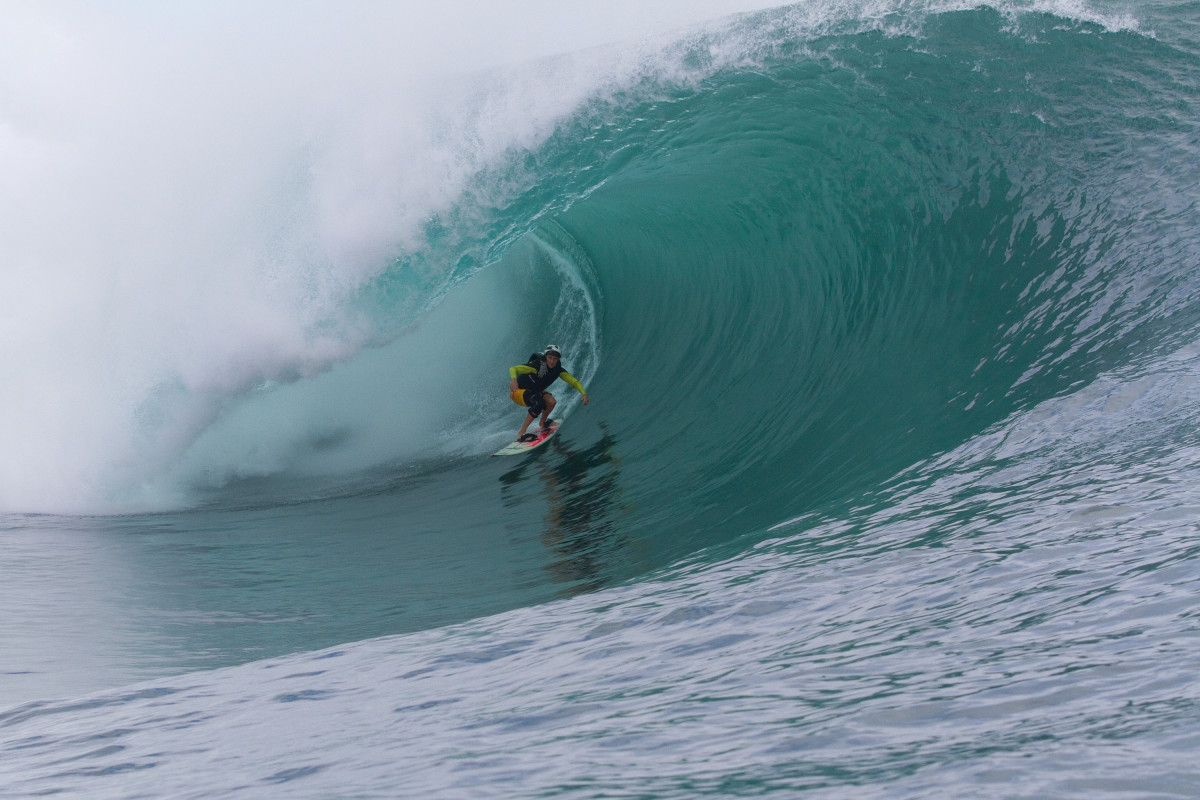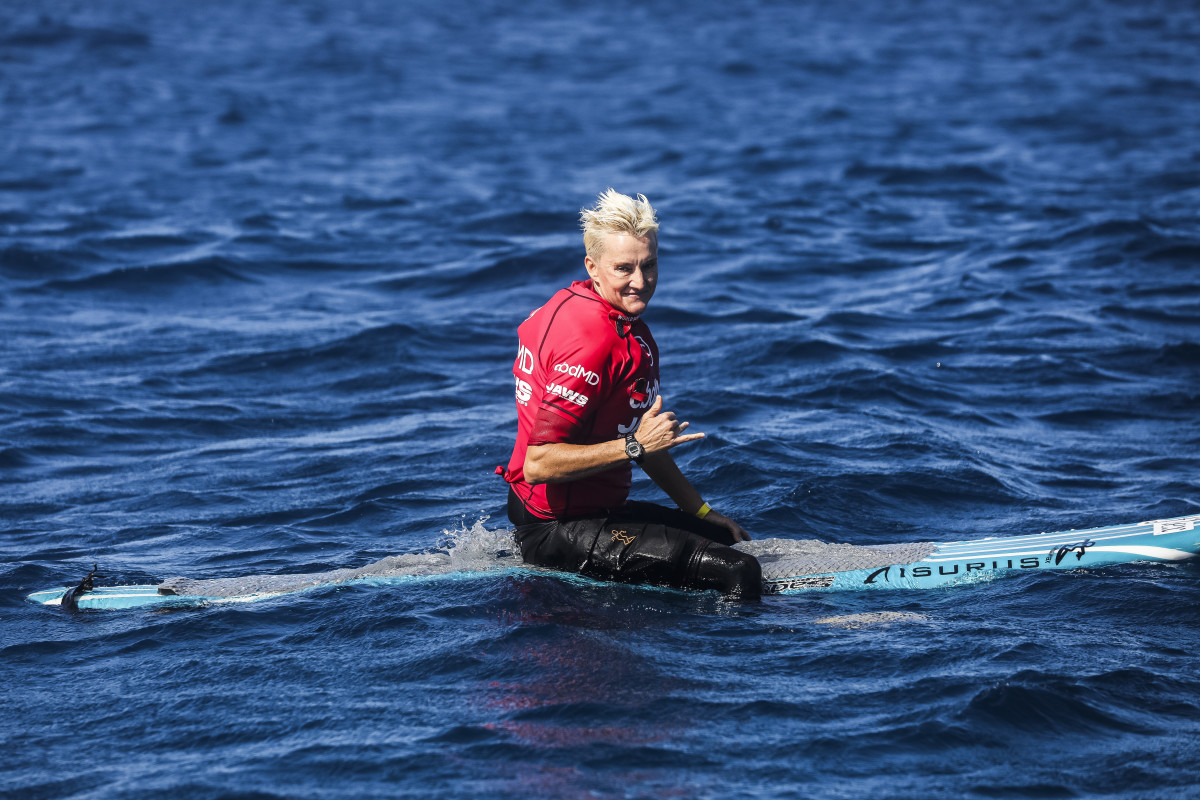Keala Kennelly’s surfing career is a storied one. Despite being one of the best surfers on the Championship Tour throughout the late ’90s and early ’00s and later one of the best big wave surfers in the world, many of Kennelly’s accomplishments have flown under the radar. Because, at the peak of her career, surf media was focused on the men.
Raised on the north shore of Kauai, Kennelly started surfing as a kid, winning multiple state titles. She graduated high school early and began competing on the Championship Tour (CT) in 1996. At that time, the tour was mainly beach breaks and Kennelly didn’t feel that she was living up to her potential as she excelled in heavier waves.
In the late ’90s, the men’s and women’s events were held at most of the same locations. Eventually bigger waves like Teahupo’o and Tavarua were added to the tour and those were the waves on which Kennelly shined.
Although Kennelly was experiencing success on tour, she was struggling internally. The men didn’t greet the women on tour with open arms and Kennelly didn’t feel comfortable coming out as a lesbian.
“It was kind of like a cautionary tale when I first got on tour, don’t be gay or you’ll have no sponsors and we’ll treat you really badly,” says Kennelly. “And beyond that [the men] just treated the women so badly.”

Steve Robertson / WSL / Getty
Kennelly recalls that a men’s heat would be in the water and when conditions would turn south, they would end the men’s round midway through and bring out the women. They didn’t try to be subtle about it, the favoritism was blatant. Additionally, the women were being paid significantly less than the men despite surfing the same waves.
“The men on tour back then had no respect for the women,” recalls Kennelly. “They were like this is our tour and you b*tches are lucky to even be here.”
This year, during the CT stop at Teahupo’o, Tatiana Weston-Webb dropped into a massive barrel, earning herself a perfect 10. The internet went wild, deeming it the first 10 ever at Teahupo’o for a woman. But that milestone had already been accomplished by Kennelly in 2001.
Kennelly hopped online, searching for proof of her 10. She kept coming up short until she eventually found a local newspaper article that had written about it. There was no footage of her ride and little to no media coverage because at that time, the eyes were on the men.
“You can’t be the first person to do something if someone’s already done it,” says Kennelly. “Now that accomplishment will forever be tied to [Tatiana’s] name.”
During most of her time on tour, Kennelly had long blonde hair and was a closet lesbian, trying to fit into the mold of what sponsors wanted. She did have good sponsors, but her last year on tour she brought her girlfriend along and promptly lost three of her four sponsors, and her main sponsor cut her salary in half.
Around that same time, Kennelly was getting into big wave surfing and was pioneering waves of consequence for women. Her sponsor told her if she that if she could get enough coverage, they would bring her salary back up.

Cait Miers / WSL / Getty
Kennelly became the first woman to tow into Teahupo’o and she landed the cover of Australia Surf Life magazine. Additionally, she had a double page spread in SURFER for a huge barrel she got at Puerto Escondido. Despite her successes, her salary continued to decrease because her sponsor claimed they didn’t have the budget.
“Meanwhile they have all this budget to pay models that don’t really surf or are terrible surfers,” says Kennelly. “I feel like their reasoning was ‘you’re not marketable enough,’ which was code for you’re a lesbian and you’re not feminine enough.”
In 2006, Kennelly got an offer to go to Hollywood and act in an HBO series. She was nursing some disk injuries and Teahupo’o and Tavarua, her best events, were being cut from the tour.
“When they took those events away there was nothing on tour for me anymore,” says Kennelly. “I wasn’t going to win a world title in grovel waves. And then I got this incredible offer to go to Hollywood and do acting, so it all seemed like everything was telling me to leave the tour.”
In 2016, Kennelly won the Barrel of the Year Award at the XXL Big Wave Awards for her barrel at Teahupo’o, making her the first woman to ever win the award. Around the same time, WSL announced that they were going to let the women compete at Jaws, but women still weren’t allowed to compete at the Titans of Mavericks, which at the time was run by a group of men who referred to themselves as “The Cartel.”
Kennelly rallied with big wave surfers Bianca Valenti, Paige Alms, and Andrea Moller as well as an activist and female lawyer to push for women’s inclusion in big wave contests. They worked with a lawyer and went to hearings, arguing that it was unconstitutional to gender discriminate on state lands. And they won.
Related: Surfing’s Next Generation of Young Women Are Bustin’ Down the Glass Ceiling
Unfortunately, The Cartel got around including women by allowing women to be beach marshals or including them on the first list of competitors but not allowing them to make the final cut and compete.
In 2017, WSL took over management of the Titan of Mavericks contest and opted to include women in the contest. Kennelly, Valenti, Moller, and Alms pushed back, demanding equal pay as the men. The event almost didn’t run, and the four women received a lot of hate online, but eventually WSL agreed to their demands and announced that they were going to provide equal pay for women across all their platforms.
Around 2016, Kennelly was surfing near her home on the North Shore of Oahu and noticed that women weren’t being included in many of the local events. Because she was no longer on tour, she’d failed to notice and when she did some research, she learned that women hadn’t been included in the Triple Crown for ten years.
In 2019, Kennelly used the same formula she’d used at Maverick’s and went to the Hawaii state government, drafting resolutions that said you couldn’t gender discriminate on state lands. In 2020, the resolution passed. The resolution become a bill, and the bill also passed, making it illegal to pull a permit for a professional surfing event in Hawaii and exclude the women.
Related: 18-Year-Old Caity Simmers Makes History As Youngest Women’s World Champ Ever
A couple of years ago, Kennelly caught wind that the Paris 2024 Olympics were to be held at Teahupo’o, her favorite wave in the world. She briefly considered trying to qualify. Despite being in her 40s, she qualified for and competed in a couple Championship Series events in Australia and quickly discovered she was past her prime. While she somberly realized her Olympic dreams were behind her, she was happy to see the ways the tour had changed for the better for the women.
Women’s surfing has come a long way in the past decade thanks to women like Kennelly. In 2019, women began receiving equal pay as men in all WSL sanctioned events. In 2022, eighteen women competed in the Pipe Pro as an official stop on the CT. In 2023, six women competed in massive conditions at the Eddie Aikau Big Wave Invitation. In 2024, women charged at the Paris 2024 Olympics at Teahupo’o, showing the world what they’re capable of.
And this is just the beginning. Because now, the eyes, and the cameras, are finally, deservedly, on the women.
“I fought for a lot of things, but it took a really long time for that change to happened and unfortunately I aged out and didn’t really get to benefit from the things I fought for,” says Kennelly. “But I get to leave an amazing legacy for all the future generations so that is the prize for me.”
Related: Interview: Maya Gabeira Talks Books, Big Waves and Life-Altering Wipeouts

